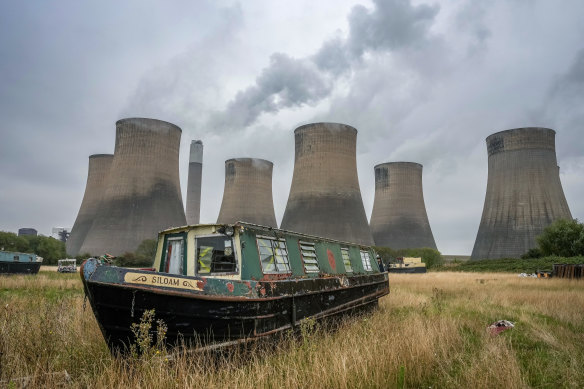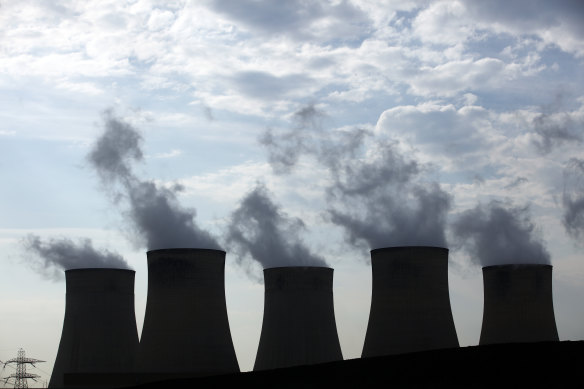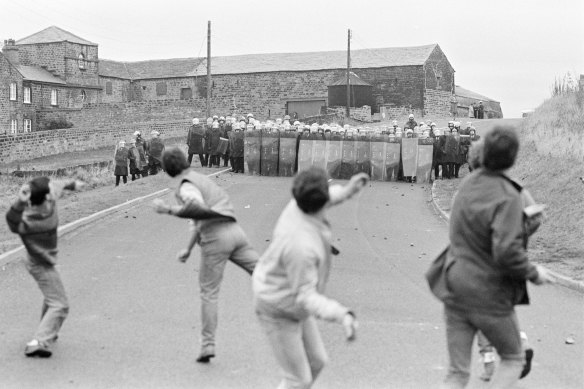By Rob Harris
Ratcliffe-on-Soar: In many ways, coal was the commodity that made Britain. It drove politics, an empire and trade. It powered the Industrial Revolution and created the world’s first coal-fired economy.
It was the industry that made almost all others possible. And culturally, the 1980s miners’ strike – the biggest industrial dispute in the post-war period and a turning point in the history of British coal mining – still casts a long shadow over the UK.

Narrow boats waiting for renovation stand in a marina yard next to the eight giant cooling towers of Ratcliffe-on-Soar power station in Nottinghamshire. The power station, operated by German-owned Uniper, is the last coal-fired station in the UK. Credit: Getty Images
On Monday, the UK’s last remaining coal-fired power station will be turned off for good, drawing to a close Britain’s 142-year reliance on the fossil fuel to produce electricity. It will be done with surprisingly little fanfare nor sentimentality.
Home to the world’s first coal-fired power station, the Holborn Viaduct power station in London in 1882, the UK will be the first G7 country to stop using coal for power generation, one year earlier than first set out by the previous Conservative government in 2015.
Ratcliffe-on-Soar power station, 170 kilometres north of London, has been generating electricity since 1968 via its four coal-fired boilers, eight vast cooling towers and 199-metre tall chimney. At its peak, it generated enough electricity to make more than 1 billion cups of tea per day.

The turbines and cooling towers that dominate the landscape will fall silent today, ending the era of coal electric generation.Credit: Bloomberg
Alighting from the train at the local station, East Midlands Parkway, provides day trippers, such as this journalist, with a spectacular view of the giant cooling towers, which rise seemingly within touching distance of the platform. Locals say they’ll miss them when they are demolished in the coming months.
John Roberts, a supervisor who joined the plant in Nottinghamshire at just 16, has been the face of the 170 workers employed by plant owner Uniper. About half of Ratcliffe’s current workforce will remain on the site until 2025 to decommission it before the demolition begins. Many will move on to other jobs or, like Roberts, retire.
“It’s going to be a momentous occasion,” he said in one of his many interviews. “It’s like a big Meccano set, and I love it. She’s an old lady now and she needs a lot of looking after.”
Shutting Ratcliffe-on-Soar is a symbolic step in the UK’s ambition to decarbonise electricity by 2030, and become carbon-neutral by 2050. The date was brought forward in 2021 by then-prime minister Boris Johnson, as he sought to show the UK’s climate leadership before the UN annual climate change summit in Glasgow that year.

The roots of Britain’s industrial decline: Clashes between striking miners and police in the town of Woolley, in Yorkshire, in 1984 during the miners’ strike.Credit: Getty Images
Germany plans to do the same by 2038, Canada by 2030 and Italy from the end of 2025, excluding the island of Sardinia. Most concede it won’t be as easy as it sounds.
Just 12 years ago, coal plants were supplying 40 per cent of the UK’s electricity, and the country only had its first coal-free day in 2017.
Last year, coal use by fell 23 per cent and is now just 1.1 per cent of the British energy mix, with 34.7 per cent coming from gas, 32.8 per cent from wind and solar, 11.6 per cent from bioenergy, and 13.8 per cent from its five nuclear sites. The rest is imported via interconnectors from mainland Europe.
In addition to the growth of renewables, another factor allowing the rapid phase-out of UK coal generation has been the fall in electricity demand since 2005, thanks to a combination of energy-efficiency regulations, LED lighting and the offshoring of some energy-intensive industries.
“It is a milestone that should be celebrated, and one that serves as an inspiration to other countries around the world to follow suit,” says Daniel Therkelsen, campaign manager at campaign group Coal Action Network.
He says in eliminating coal from the energy mix, the UK has taken a crucial step in reducing its carbon footprint and improving air quality.
But looking ahead, Therkelsen says the challenge now is to ensure that the UK’s energy system remains reliable and affordable as it continues to transition towards renewable sources.
Ratcliffe has had about 141,768 coal deliveries by rail from the neighbouring collieries of Nottinghamshire by rail since 1967, with the last coal shipment taking place in June.
Analysis from Carbon Brief found this week that from 1882 until Ratcliffe’s closure, the UK’s coal plants will have burned through 4.6 billon tonnes of coal and emitted 10.4 billon tonnes of carbon dioxide – more than most countries have ever produced from all sources.
Chris Kitchen, the general secretary of the National Union of Mineworkers, says Ratcliffe’s closure marks the end of an industrial decline that has its roots four decades ago in the miners’ strikes. Many former coal mining communities remain impoverished, and this period has been cited as a “failed just transition” for coal workers.
Kitchen concedes while Britain may be greener, it has lost something important in the process.
“The coal industry never made great profits, you know. It was about the national good,” he said in a radio interview this week.
“I’m not a dinosaur who wants to exist in the dark ages. We do need to address climate change, but let’s do it without the blinkers on.”
Get a note directly from our foreign correspondents on what’s making headlines around the world. Sign up for the weekly What in the World newsletter here.